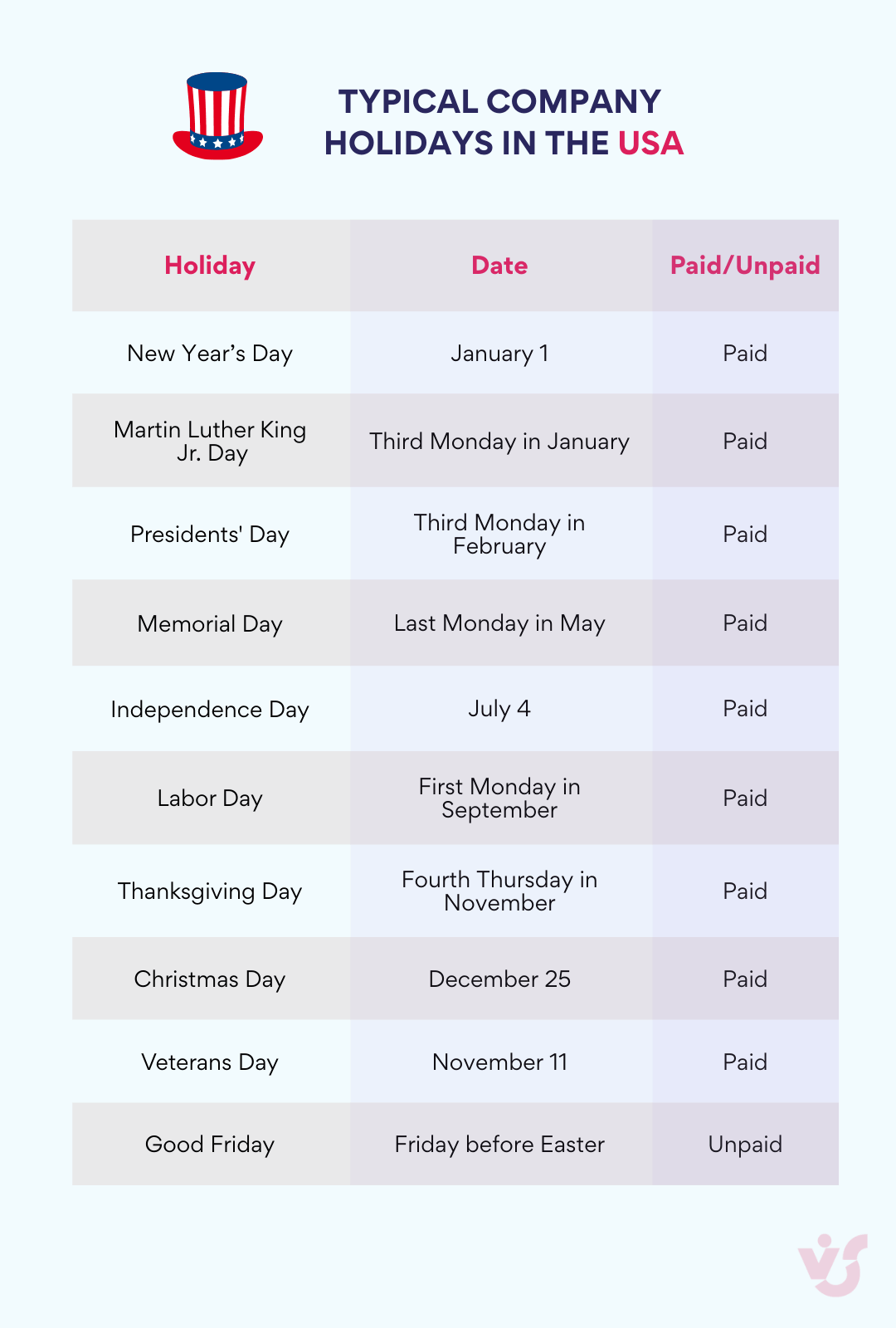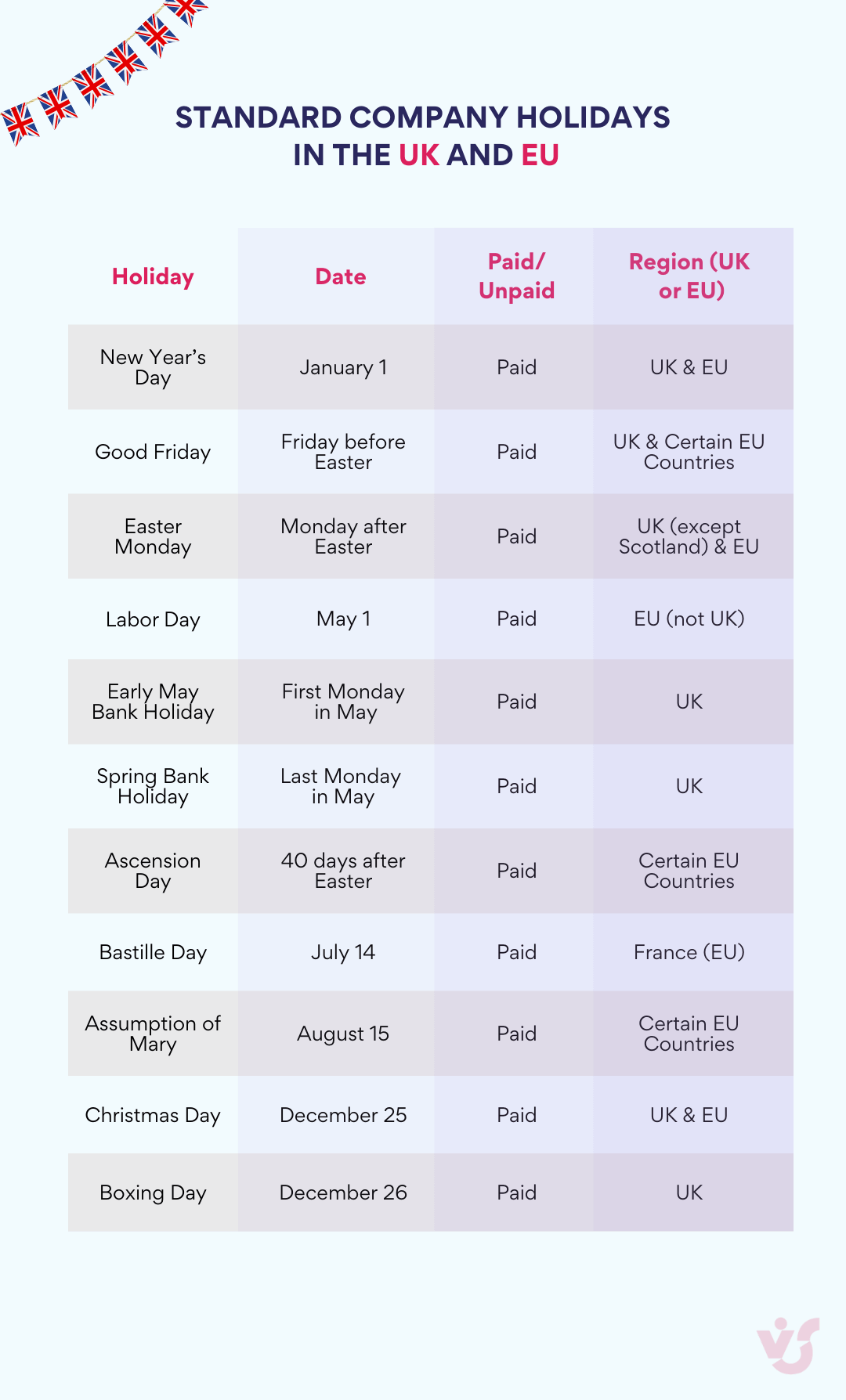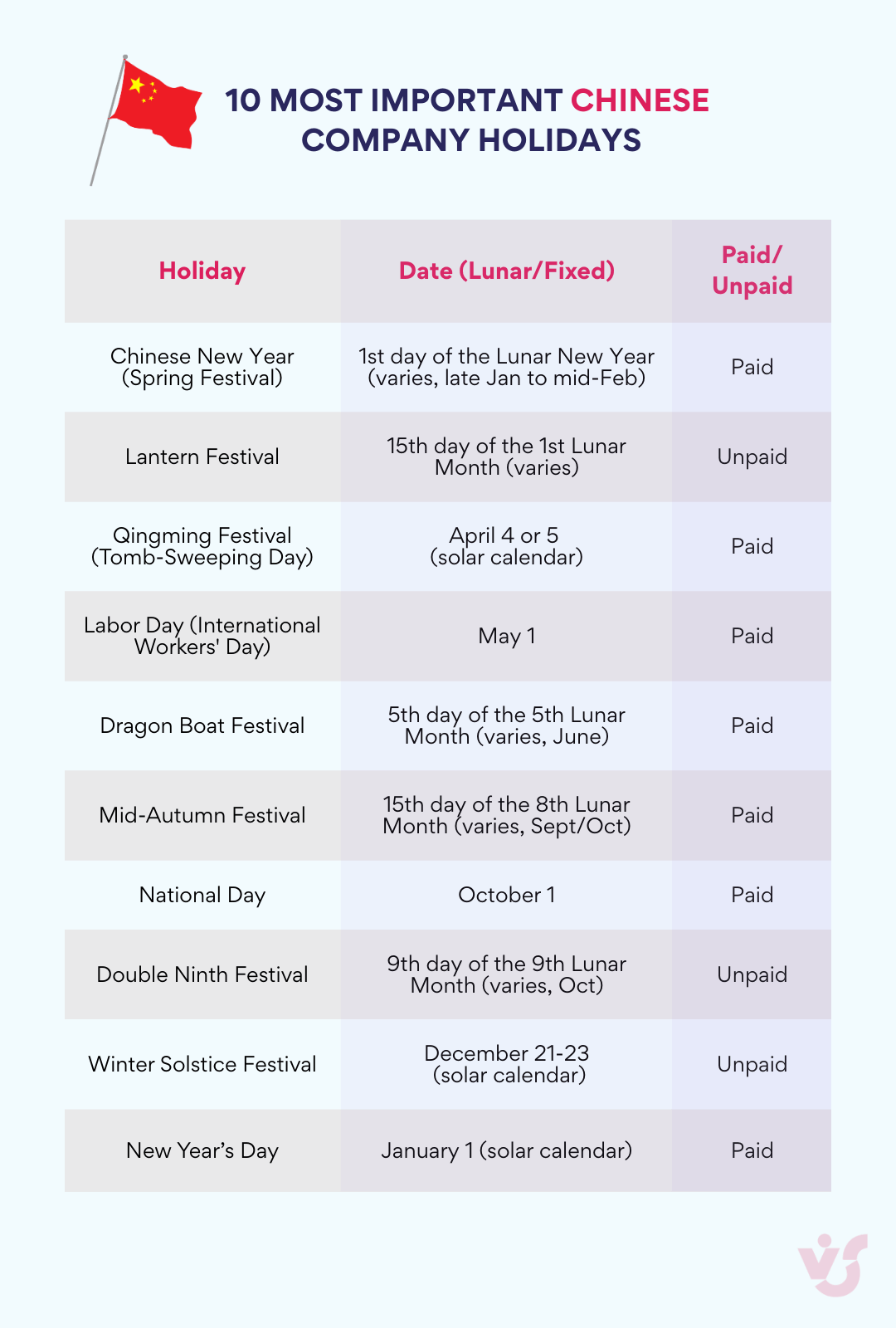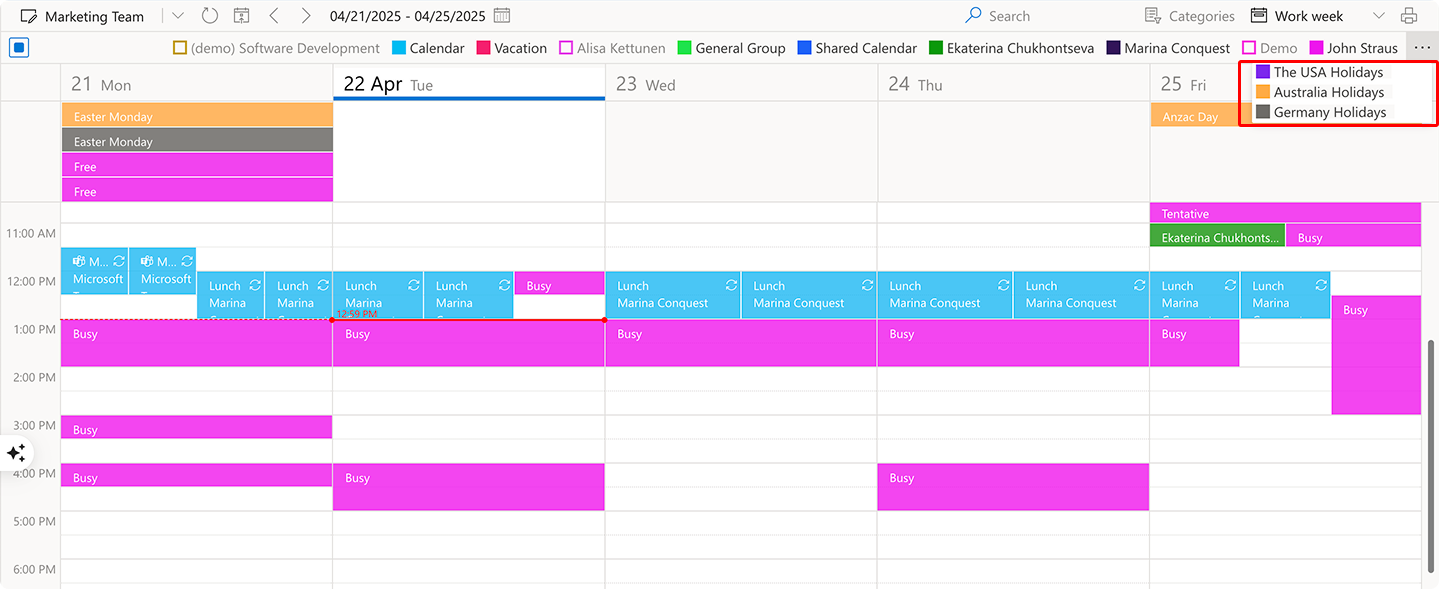The concept of company holidays extends far beyond public holidays recognized by governments. It also includes internal corporate holidays—specific days off that are regulated by individual company policies. These internal holidays might be tied to company milestones, cultural traditions, or industry-specific practices, and they often vary widely depending on the organization and its location. Understanding these nuances is essential for employees and employers alike to navigate work-life balance effectively.
Equally important is distinguishing between different types of holidays, such as paid and unpaid holidays, as well as mandatory versus recommended days off. Paid holidays, for instance, ensure employees are compensated while taking time away from work, whereas unpaid holidays don’t offer financial security but may still be an important option for personal time. Recognizing whether a day off is legally mandated or simply suggested by the company can help avoid misunderstandings and ensure compliance with local labor laws.
The purpose of this article is to provide a comprehensive overview of what typical company holidays encompass, how they are regulated, and how holiday policies are crafted. Additionally, we’ll explore practical strategies for managing and tracking holidays across international teams, ensuring smooth collaboration and fairness in today’s globalized workplace.
What Are Company Holidays and Why Are They Needed
Company holidays represent official non-working days established either by the organization itself or coinciding with state or federal holidays. During these designated periods, employees are released from their regular work responsibilities, allowing them to rest, celebrate, or observe important cultural or religious traditions.
In most cases, company holidays are paid days off, meaning employees receive their regular compensation despite not working. However, the specific conditions—including which holidays are observed and whether they’re paid—ultimately depend on the internal policies established by each organization.
It’s important to distinguish between company holidays and vacation time. While both provide time away from work, company holidays are predetermined days off that apply to all eligible employees simultaneously. Vacation time, by contrast, represents personalized time off that employees schedule according to their individual needs and preferences, often requiring manager approval and coordination with team schedules.
👉 What is a company holiday? A company holiday is an officially designated non-working day when employees are not required to perform their regular duties while typically still receiving their standard compensation.
Why Clear Company Holiday Policies Matter
Establishing clear policies around company holidays serves multiple crucial purposes for both organizations and their employees. A well-structured approach to holiday observance addresses compliance requirements, supports workforce planning, and contributes significantly to organizational culture:
- Legal requirements: Many countries mandate certain paid holidays as part of their labor laws. For example, in France, employees are entitled to 11 public holidays annually, while Japan recognizes 16 national holidays. Companies must comply with these regulations or face potential penalties.
- Fairness and transparency: A well-defined holiday policy ensures all employees understand which days they can reliably count as non-working days. This clarity eliminates confusion and prevents situations where employees might be unexpectedly required to work while colleagues are off.
- Positive workplace culture: Paid holidays significantly contribute to employee satisfaction and promote healthier work-life balance. Organizations that recognize important cultural and religious holidays demonstrate respect for employee diversity and well-being, which can enhance company morale and retention.
- Operational planning: Established holiday schedules allow companies to effectively organize workflows, project timelines, and resource allocation. When everyone knows in advance which days the office will be closed, teams can plan accordingly to meet deadlines and ensure adequate coverage during operational periods.
👉 What is the meaning of paid holiday work? Paid holiday work refers to when employees are required to work on a designated holiday and receive compensation for their time, often at a higher rate than their standard pay. This could include overtime pay, holiday premiums, or additional time off as compensation. Such arrangements vary by company policy, labor laws, and the type of holiday. Employers may also provide compensatory days off to employees who work during holidays. Paid holiday work ensures that essential operations continue while compensating employees fairly for their time.
What holidays do most companies give off?
In the United States, standard company holidays typically include:
- New Year’s Day (January 1)
- Memorial Day (last Monday in May)
- Independence Day (July 4)
- Labor Day (first Monday in September)
- Thanksgiving Day (fourth Thursday in November)
- Christmas Day (December 25)
Many companies enhance this basic framework with additional observed holidays such as Martin Luther King Jr. Day, Presidents’ Day, Veterans Day, Christmas Eve, or Black Friday. Some progressive organizations have also introduced floating holidays—flexible days off that employees can use at their discretion, often to observe personal, cultural, or religious occasions not covered by the standard holiday calendar.
Below is a table listing 10 typical company holidays in the USA, the UK, and the EU, specifying whether they are typically paid or unpaid and including their dates:

👉What do company holidays mean? Company holidays represent an organization’s recognition of important cultural, national, or religious observances, along with their commitment to employee well-being by providing scheduled time away from work responsibilities.
What Paid Holidays Include and How They Work
A paid holiday represents a day when an employee is not required to work but still receives their standard compensation. This practice allows employees to observe important cultural, religious, or national occasions without sacrificing income, while providing employers with a valuable tool for enhancing workplace satisfaction and competitive benefits packages.
👉What is included in holiday pay? Holiday pay typically includes an employee’s regular base wages for their standard working hours. Depending on company policy, it may also incorporate regular bonuses or commissions, but often excludes overtime premiums or special allowances.
Types of paid holidays
Here are types of paid holidays in the US:
- Federal holidays: These are officially recognized by the United States government, during which federal offices close and federal employees receive paid time off. While private employers are not legally obligated to observe federal holidays or provide payment for them, many choose to do so as a standard practice. The U.S. currently observes 11 federal holidays, including New Year’s Day, Independence Day, and Thanksgiving.
- State holidays: Individual states may designate additional holidays beyond those recognized federally. Examples include Patriots’ Day in Massachusetts and Maine, Cesar Chavez Day in California, and Juneteenth in many states prior to its federal recognition. Employers determine whether to incorporate these state-specific observances into their holiday policies.
- Corporate or internal holidays: These company-specific observances are established at the discretion of the employer. They might include the organization’s founding anniversary, days surrounding major holidays (like Christmas Eve or New Year’s Eve), floating holidays, or company-wide mental health days. Tech companies, for instance, increasingly offer “shutdown periods” between Christmas and New Year’s as additional paid time off.
👉What holidays do people usually get paid for? Most U.S. companies that offer paid holidays cover the six major federal holidays: New Year’s Day, Memorial Day, Independence Day, Labor Day, Thanksgiving Day, and Christmas Day. Many add Martin Luther King Jr. Day, Presidents’ Day, Veterans Day, and increasingly, Juneteenth.
How paid holidays are regulated
Paid holiday policies are established and governed through various mechanisms:
- Employment Contracts: Individual employment agreements may specify which holidays are paid and under what conditions. This is particularly common for executive positions or specialized roles with negotiated benefits packages.
- Collective Bargaining Agreements: Organizations with unionized workforces typically have holiday policies determined through collective bargaining. These agreements often secure more generous holiday provisions than non-unionized counterparts, including additional paid holidays or enhanced compensation for holiday work.
- Company Policy: For most businesses, holiday policies are outlined in employee handbooks or policy manuals. These internal regulations establish which holidays the company observes, eligibility requirements (such as employment status or length of service), and procedures for holiday scheduling or substitution.
- Labor Laws: Unlike many countries worldwide, the United States does not mandate paid holidays at the federal level. The Fair Labor Standards Act (FLSA) does not require employers to provide paid time off for holidays. However, some states and municipalities have implemented their own requirements, particularly for public sector employees.
When employees are required to work on designated holidays, many organizations provide premium compensation. Common approaches include “time-and-a-half” (1.5× regular pay), double-time (2× regular pay), or compensatory time off. Healthcare, hospitality, retail, and emergency services frequently implement such policies to ensure coverage while acknowledging the sacrifice of working during holidays.
👉How many paid holidays do most companies give? The average American company offers 7-11 paid holidays annually. According to Bureau of Labor Statistics data, private industry workers receive an average of 8 paid holidays per year, while public sector employees typically receive 10-11. However, this varies significantly by industry, company size, and employee classification.
Company Holidays Calendar by Country and Industry
Understanding company holiday practices across various countries and industries is essential for multinational organizations and employees alike. These schedules reflect not only legal requirements but also cultural values, historical traditions, and practical business considerations that shape workplace expectations worldwide.
Holiday observances vary dramatically across regions, influenced by diverse factors including religious traditions, national commemorations, and seasonal patterns. While most organizations align their holiday policies with state or federal designations, implementation approaches differ significantly based on local regulations, industry demands, and company culture.
Global holiday approaches
Each region of the world maintains distinctive approaches to company holidays, reflecting local cultural traditions, religious observances, and historical commemorations. These varied practices create a complex global landscape where organizations must navigate different expectations and requirements. From North America’s emphasis on national holidays to Europe’s mix of religious and civic observances and Asia’s lunar calendar celebrations, understanding these regional patterns is crucial for international businesses and their employees:
USA
American companies typically observe 7-11 paid holidays annually, focusing on federal holidays like:
- New Year’s Day (January 1)
- Martin Luther King Jr. Day (third Monday in January)
- Presidents’ Day (third Monday in February)
- Memorial Day (last Monday in May)
- Juneteenth (June 19)
- Independence Day (July 4)
- Labor Day (first Monday in September)
- Columbus Day/Indigenous Peoples’ Day (second Monday in October)
- Veterans Day (November 11)
- Thanksgiving Day (fourth Thursday in November)
- Christmas Day (December 25)
European Union
The EU lacks unified holiday regulations, with each member state maintaining its own schedule of public holidays based on national traditions and religious observances. While the Working Time Directive ensures at least 4 weeks of annual leave, public holiday policies vary by country:
- Germany: 9-13 holidays (varies by state), including:
- New Year’s Day (January 1)
- Good Friday (variable date)
- Easter Monday (variable date)
- Labor Day (May 1)
- Ascension Day (variable date)
- German Unity Day (October 3)
- Christmas Day (December 25)
- Boxing Day (December 26)
- France: Approximately 11 holidays, including:
- New Year’s Day (January 1)
- Easter Monday (variable date)
- Labor Day (May 1)
- Victory in Europe Day (May 8)
- Ascension Day (variable date)
- Bastille Day (July 14)
- Assumption Day (August 15)
- All Saints’ Day (November 1)
- Armistice Day (November 11)
- Christmas Day (December 25)
- Spain: 14 holidays, combining national and regional observances:
- New Year’s Day (January 1)
- Epiphany (January 6)
- Good Friday (variable date)
- Labor Day (May 1)
- Assumption Day (August 15)
- National Day (October 12)
- All Saints’ Day (November 1)
- Constitution Day (December 6)
- Immaculate Conception (December 8)
- Christmas Day (December 25)

United Kingdom
UK companies typically observe 8 bank holidays, including:
- New Year’s Day (January 1)
- Good Friday (variable date)
- Easter Monday (variable date)
- Early May Bank Holiday (first Monday in May)
- Spring Bank Holiday (last Monday in May)
- Summer Bank Holiday (last Monday in August)
- Christmas Day (December 25)
- Boxing Day (December 26)
Asia

Asian holiday calendars show remarkable diversity:
- China: 13 public holidays, including:
- New Year’s Day (January 1)
- Spring Festival/Chinese New Year (variable dates, typically late January or February, 7-day celebration)
- Qingming Festival (April 4 or 5)
- Labor Day (May 1-3)
- Dragon Boat Festival (5th day of 5th lunar month)
- Mid-Autumn Festival (15th day of 8th lunar month)
- National Day (October 1-7)
- Japan: 16 official holidays, including:
- New Year’s Day (January 1)
- Coming of Age Day (second Monday in January)
- National Foundation Day (February 11)
- Emperor’s Birthday (February 23)
- Vernal Equinox Day (around March 20)
- Showa Day (April 29)
- Constitution Memorial Day (May 3)
- Greenery Day (May 4)
- Children’s Day (May 5)
- Marine Day (third Monday in July)
- Mountain Day (August 11)
- Respect for the Aged Day (third Monday in September)
- Autumnal Equinox Day (around September 23)
- Sports Day (second Monday in October)
- Culture Day (November 3)
- Labor Thanksgiving Day (November 23)
- South Korea: 11 public holidays, featuring:
- New Year’s Day (January 1)
- Seollal/Lunar New Year (variable dates, typically January or February, 3-day celebration)
- Independence Movement Day (March 1)
- Buddha’s Birthday (8th day of 4th lunar month)
- Children’s Day (May 5)
- Memorial Day (June 6)
- Constitution Day (July 17)
- Liberation Day (August 15)
- Chuseok/Harvest Festival (15th day of 8th lunar month, 3-day celebration)
- National Foundation Day (October 3)
- Hangul Day (October 9)
👉 What are standard paid holidays in the UK and France? In the UK, standard paid holidays often include bank holidays such as New Year’s Day, Good Friday, Easter Monday, Christmas Day, and Boxing Day, though employers are not legally obligated to provide time off for these. Many companies also include Early May Bank Holiday or Spring Bank Holiday as part of their paid leave benefits. In France, standard paid holidays include public holidays such as Bastille Day (July 14), May Day (May 1), Armistice Day (November 11), and Christmas Day (December 25). While not all public holidays are mandatory for private companies in France, most employers offer them as paid days off. Both countries require employers to adhere to labor laws regarding minimum annual leave, separate from public holidays.
Fixed vs. flexible holiday approaches
Companies typically implement one of two primary approaches to holiday scheduling:
- Fixed holiday calendar: Organizations predetermine specific dates as non-working days for all employees. This traditional approach ensures operational predictability and uniform scheduling but offers limited personalization.
- Flexible holiday systems: Increasingly popular models include:
- Floating holidays that employees can schedule at their discretion
- Holiday exchanges allowing substitution of standard holidays for personally significant dates
- PTO banks combining holiday, vacation, and personal days into a single allocation
Many modern organizations adopt hybrid models, maintaining core holidays while offering flexibility for remaining observances.
👉What is a typical company holiday schedule? Most companies observe between 8-12 paid holidays annually, typically including major national celebrations, cultural observances, and religious holidays relevant to their region. North American organizations generally provide 7-11 paid holidays, while European companies often observe 10-14, and Asian businesses range from 11-16 depending on the country.
Industry-specific holiday practices
Holiday implementation varies dramatically across sectors based on operational requirements:
- Retail, hospitality, healthcare, and transportation: These customer-facing industries typically maintain operations during holidays, as these periods often represent peak demand. Employees frequently work during official holidays with compensatory benefits including:
- Premium pay (often 1.5-3 times regular wages)
- Alternative days off (comp time)
- Rotating holiday schedules ensuring equitable distribution of holiday work
- IT, Finance, and Education: Knowledge-based sectors generally follow standard holiday schedules with offices closed on major national holidays. Trends include:
- Extended holiday closures (particularly between Christmas and New Year)
- Remote work flexibility surrounding holidays
- Summer slowdowns or reduced schedules
- Manufacturing: Production requirements determine holiday practices:
- Continuous operations (24/7 facilities): Holiday premiums and shift rotations maintain production while compensating workers
- Intermittent operations: Holiday shutdowns may align with maintenance needs or seasonal demand patterns
- Hybrid approaches: Essential personnel receive premium compensation while non-essential operations pause
👉 What are the paid holidays? Paid holidays are days off from work where employees receive their regular pay without needing to work. Common examples include public or federal holidays such as New Year’s Day, Independence Day, Thanksgiving, and Christmas in the U.S. In addition to these, companies may offer additional paid holidays like the day after Thanksgiving, Christmas Eve, or floating holidays that employees can choose. The specific paid holidays vary by country, region, and company policy. These holidays are typically outlined in employment contracts or company handbooks
Typical paid holidays by country
Here’s a summary of public holidays discussed across countries:
| Country | Standard paid holidays | Notable observances |
| USA | 7-11 | New Year’s Day (Jan 1), Independence Day (Jul 4), Thanksgiving (4th Thu in Nov), Christmas (Dec 25) |
| Germany | 9-13 | New Year’s Day (Jan 1), Labor Day (May 1), German Unity Day (Oct 3), Christmas (Dec 25-26) |
| France | 11 | New Year’s Day (Jan 1), Labor Day (May 1), Bastille Day (Jul 14), All Saints’ Day (Nov 1) |
| UK | 8 | New Year’s Day (Jan 1), Good Friday (variable), Early May Bank Holiday (1st Mon in May), Christmas (Dec 25-26) |
| China | 13 | Spring Festival/Chinese New Year (variable, Jan/Feb), Labor Day (May 1-3), National Day (Oct 1-7) |
| Japan | 16 | New Year’s Day (Jan 1), Golden Week (Apr 29-May 5), Respect for the Aged Day (3rd Mon in Sep), Emperor’s Birthday (Feb 23) |
| South Korea | 11 | Seollal (variable, Jan/Feb), Independence Movement Day (Mar 1), Chuseok (variable, Sep/Oct) |
👉What days are corporate holidays? Standard corporate holidays vary by region but typically include New Year’s Day (January 1), labor-related observances (May Day/Labor Day), major national celebrations (Independence Day, National Day), and end-of-year holidays (Christmas, December 25). Religious observances like Easter (variable dates in March/April), Diwali (variable dates in October/November), or Eid (variable dates based on Islamic calendar) may be included depending on the country’s predominant faiths and cultural practices.
Organizing Company Holidays for International Teams
Managing company paid holidays across a global workforce presents unique challenges for multinational organizations. This section explores effective strategies for harmonizing diverse holiday schedules, preventing scheduling conflicts, and creating inclusive policies that respect cultural differences while maintaining operational efficiency.
Navigating global holiday diversity
International companies must accommodate different holiday schedules across the various countries where their employees work. This complexity requires thoughtfully designed HR policies and specialized tools to track regional variations and ensure smooth business operations.
Standard approaches like “one-size-fits-all” holiday calendars become impractical when teams span multiple continents and cultural traditions. Instead, organizations need flexible frameworks that acknowledge local observances while maintaining global cohesion.
Key challenges in international holiday management
The coordination of company holidays across international teams introduces several operational hurdles that organizations must systematically address. These challenges extend beyond simple calendar differences to include cultural understanding, workflow continuity, and employee satisfaction considerations. Without effective management strategies, these issues can impact both productivity and team cohesion.
- Diverse national observances: Countries observe fundamentally different holidays based on historical events, religious traditions, and cultural practices. For example, while American employees celebrate Thanksgiving on the fourth Thursday of November, Canadian colleagues observe their Thanksgiving on the second Monday of October. Similarly, cultural observances like Diwali, Ramadan, Lunar New Year, and Orthodox Christmas may be essential holidays in some regions but unfamiliar in others.
- Communication misalignments: Team members often lack awareness of colleagues’ local holidays, leading to inadvertent scheduling conflicts. Without visibility into regional differences, employees might arrange critical meetings during another office’s holiday, resulting in canceled appointments, delayed projects, and disrupted workflows. These misunderstandings can accumulate, creating significant operational inefficiencies.
- Coordination complexities: Managers face particular challenges when assigning tasks, scheduling deliverables, and planning project timelines across global teams. Without comprehensive holiday awareness, organizations risk creating unrealistic deadlines that coincide with multiple regional holidays or scheduling critical presentations when key team members are observing important cultural traditions.
Best practices for international holiday management
Organizations can address these challenges through structured approaches that balance respect for cultural diversity with operational needs. The following strategies provide a framework for effectively managing holiday schedules across international teams while maintaining productivity and fostering an inclusive workplace culture.
- Implement centralized calendar systems: Create a comprehensive global calendar that integrates all relevant regional holidays and makes this information accessible company-wide. These centralized systems should:
- Sync seamlessly with workplace tools like Microsoft Outlook, Google Calendar, Slack, and Microsoft Teams
- Use visual indicators to distinguish between global company holidays and regional observances
- Provide automatic notifications when scheduling conflicts with regional holidays arise
- Enable regional filtering: Allow employees to customize calendar views based on relevant locations while maintaining visibility into global operations:
- Implement location-based filtering that prioritizes an employee’s home country holidays
- Create team-specific views that highlight holidays affecting all relevant team members
- Maintain the ability to temporarily view all regional holidays when planning international initiatives
- Incorporate holidays into project planning: Ensure project managers and team leaders proactively account for holiday variations when establishing workflows:
- Build holiday-related buffer time into global project timelines
- Distribute critical path responsibilities to avoid single-region bottlenecks during major holidays
- Consider holiday concentration periods (like December in Western countries or Lunar New Year in Asia) when setting quarterly targets
- Develop comprehensive holiday policies: Document clear approaches to international holiday management in formal HR policies:
- Establish guidelines for handling overlapping or conflicting holidays across teams
- Define processes for requesting time off for locally significant holidays not included in the standard calendar
- Create equity-centered frameworks ensuring consistent paid time off despite regional holiday variations
- Address holiday expectations for employees temporarily working in different regions
- Maintain up-to-date holiday information: Establish systems for regularly reviewing and updating holiday data:
- Conduct annual audits of holiday schedules across all operating regions
- Designate specific accountability for holiday calendar maintenance, typically assigned to HR representatives or international project coordinators
- Create notification systems for mid-year holiday additions or date changes
- Monitor legislative changes that might affect statutory holidays in operating regions
By implementing these strategic approaches, international organizations can transform holiday diversity from an operational challenge into a cultural strength. Well-managed holiday policies demonstrate respect for local traditions while maintaining business continuity, ultimately contributing to employee satisfaction and operational efficiency.
How to Create and Document a Holiday Policy for Employees
Developing a comprehensive holiday policy is a critical HR function that establishes clear expectations, ensures legal compliance, and promotes equitable treatment across an organization. A well-crafted policy provides transparency around time-off practices, helping employees understand their entitlements while giving management the framework needed for consistent application.
A properly documented holiday policy serves multiple essential purposes: it prevents misunderstandings about employee rights and company expectations, ensures compliance with labor regulations across all operating jurisdictions, and simplifies workforce planning. This is particularly valuable for distributed and international teams where holiday practices may vary significantly between locations.
Critical considerations for policy development
When creating an effective holiday policy, HR professionals should approach the task systematically, addressing both regulatory requirements and organizational needs. The following key considerations provide a framework for developing a comprehensive policy that balances legal compliance, operational requirements, and employee satisfaction while remaining adaptable to evolving workplace dynamics.
- Align with local labor regulations
- Incorporate all mandatory holidays established by national, state/provincial, and local authorities
- Clearly specify holiday pay requirements, noting any regional variations in compensation rates
- Document overtime or premium pay standards for employees who work during recognized holidays
- Address differences in statutory requirements across operating regions, noting where local regulations supersede company-wide policy
- Define holiday categories
- Paid holidays: Specify which federal/national, state/regional, and company-specific days qualify for holiday pay
- Unpaid observances: Outline additional recognized days when operations may continue but employees can request time off
- Floating holidays: Detail any discretionary days that employees can schedule according to personal preference, including:
- Annual allocation (typically 1-3 days per calendar year)
- Scheduling requirements and approval processes
- Expiration rules (whether unused floating holidays carry over)
- Eligibility criteria (e.g., completion of probationary period)
- Establish leave request procedures
- Outline the process for requesting time off adjacent to holidays, including:
- Required notice periods (typically longer for days surrounding major holidays)
- Submission methods (through HRIS, email templates, or paper forms)
- Approval authority and timelines for management response
- Detail how staffing needs will be balanced with employee requests
- Specify policies for handling competing requests (seniority-based, first-come-first-served, or rotation systems)
- Address coverage requirements and procedures for arranging shift replacements
- Address remote and international considerations
- Clarify which regional holiday schedule applies to employees working outside their home country
- Establish principles for synchronizing work across global teams during regional holidays
- Outline compensation options when employees work during their regional holidays, including:
- Alternative time off
- Premium pay rates
- Combination approaches
- Address expectations for availability during global versus local holidays
Essential policy components
A well-structured holiday policy document should contain several key sections that collectively provide complete guidance to both employees and managers. Each component serves a specific purpose in creating a comprehensive framework that addresses all aspects of holiday observance and administration. The following elements form the foundation of an effective policy that balances clarity, compliance, and cultural sensitivity.
Comprehensive holiday listing
- Provide complete annual holiday schedules with specific dates for fixed holidays
- Include calculation formulas for floating dates (e.g., “third Monday in January” for Martin Luther King Jr. Day)
- Distinguish between recurring annual dates and variable observances
- Note any special circumstances for holidays falling on weekends (e.g., Friday/Monday observance)
Compensation structure
- Specify which employees qualify for holiday pay (full-time, part-time, contingent workforce)
- Detail standard payment rates for recognized holidays (typically 100% of regular wages)
- Document premium rates for holiday work (commonly 1.5x to 2x standard compensation)
- Outline alternative compensation options, such as:
- Compensatory time off in lieu of premium pay
- Scheduling preferences for future requests
- Additional floating holiday allocation
Operational coverage guidelines
- Document how essential operations are maintained during holidays
- Outline duty rotation systems ensuring equitable distribution of holiday work
- Provide examples of fair rotation schedules across teams and departments
- Specify advance notice requirements for holiday staffing schedules
- Address special considerations for customer-facing and 24/7 operations
Information access protocols
- Designate official holiday calendar locations (company intranet, HRIS, shared calendars)
- Specify update frequency and notification processes for calendar changes
- Identify responsible parties for maintaining and communicating holiday information
- Detail procedures for addressing calendar discrepancies or disputes
👉 What does the term ‘holiday rules’ typically refer to? Holiday rules refer to the guidelines and policies set by a company or organization to manage employee time off, including public holidays, paid leave, and other types of absences. These rules outline eligibility for holidays, how requests for time off should be submitted, and any restrictions or blackout periods. They also define whether employees working on holidays receive additional compensation or alternative time off. Holiday rules ensure clarity, fairness, and compliance with labor laws while helping employers maintain smooth operations. Clear holiday rules are typically documented in employee handbooks or contracts.
Example company holiday policy for employees
Below is a sample holiday policy for employees that you can use as a template to create your own policy:
XYZ Corporation Holiday Policy
Effective date: January 1, 2025
Last updated: April 1, 2025
Policy owner: Human Resources Department
1. Purpose
This policy establishes guidelines for the observance of holidays at XYZ Corporation. It defines recognized holidays, eligibility for holiday benefits, and procedures for holiday scheduling to ensure consistent application across all company locations.
2. Scope
This policy applies to all full-time and part-time employees of XYZ Corporation globally. Specific provisions may vary by location to comply with local labor laws and practices.
3. Recognized holidays
3.1 Company-wide holidays
XYZ Corporation observes the following holidays at all global locations:
| Holiday | Date | Observance |
| New Year’s Day | January 1 | If falls on weekend, observed on nearest weekday |
| International Workers’ Day | May 1 | Fixed date observance |
| Company Founding Day | July 17 | Fixed date observance |
| Thanksgiving Day (US) | 4th Thursday in November | US offices closed; other locations remain open |
| Christmas Day | December 25 | If falls on weekend, observed on nearest weekday |
| December Holiday Break | December 26-31 | All offices closed for year-end break |
3.2 Regional holidays
In addition to company-wide holidays, XYZ Corporation observes location-specific holidays as required by local law and custom. A complete list of regional holidays is maintained in the Global Holiday Calendar accessible through the company intranet.
Key regional observances include:
United States:
- Martin Luther King Jr. Day (3rd Monday in January)
- Memorial Day (Last Monday in May)
- Juneteenth (June 19)
- Independence Day (July 4)
- Labor Day (1st Monday in September)
United Kingdom:
- Good Friday (Variable date)
- Easter Monday (Variable date)
- Early May Bank Holiday (1st Monday in May)
- Summer Bank Holiday (Last Monday in August)
- Boxing Day (December 26)
India:
- Republic Day (January 26)
- Independence Day (August 15)
- Gandhi Jayanti (October 2)
- Diwali (Variable date)
China:
- Chinese New Year (Variable date, typically January/February)
- Qingming Festival (April 4 or 5)
- Dragon Boat Festival (5th day of 5th lunar month)
- Mid-Autumn Festival (15th day of 8th lunar month)
- National Day (October 1)
4. Holiday eligibility and compensation
4.1 Regular full-time employees
- Eligible for paid time off for all company-wide and applicable regional holidays
- Receive regular base pay for scheduled holiday time off
- Must work scheduled days before and after the holiday unless using approved leave
- Receive 1.5x regular pay rate if required to work on a recognized holiday, plus an alternative day off to be taken within 30 days
4.2 Part-time employees
- Eligible for pro-rated holiday pay based on standard weekly hours
- Minimum 20 hours/week required for holiday pay eligibility
- Receive holiday pay only if the holiday falls on a regularly scheduled workday
- Premium pay of 1.5x regular rate applies for holiday work
4.3 Temporary and contract workers
- Not eligible for paid holiday time off
- Receive 1.5x regular rate for hours worked on company-observed holidays
- Subject to operational requirements and departmental scheduling
4.4 New employees
- Eligible for holiday pay immediately upon hire
- Must be in active pay status on the workday before and after the holiday
5. Floating holidays
5.1 Allocation
Full-time employees receive two (2) floating holidays per calendar year to accommodate personal, cultural, or religious observances not included in the standard holiday schedule.
5.2 Usage guidelines
- Available after completion of 90-day probationary period
- Must be scheduled with minimum 2-week advance notice
- Subject to manager approval based on operational requirements
- Cannot be carried over to the following year
- Not paid out upon termination of employment
6. Holiday scheduling procedures
6.1 Request process
- Submit floating holiday requests through the Time Management System
- Provide minimum 2-week notice for floating holidays (4 weeks preferred)
- Requests processed on first-come, first-served basis within departments
- Manager response provided within 3 business days
6.2 Essential operations
For departments requiring holiday coverage:
- Rotation schedules published 60 days in advance
- Volunteer sign-up period during first 14 days after schedule publication
- If insufficient volunteers, assignment based on inverse seniority rotation
- Maximum assignment of two (2) holiday shifts per employee annually
6.3 Religious accommodations
XYZ Corporation respects the diverse religious observances of all employees:
- Reasonable accommodations provided for religious observances when requested
- Employees may use floating holidays, vacation time, or unpaid time off
- Requests for religious accommodation should be submitted to direct manager with 30 days’ notice when possible
7. International and remote work considerations
7.1 Multi-location teams
- Teams spanning multiple locations will recognize all holidays observed by team members
- No mandatory meetings or critical deadlines scheduled on any team member’s recognized holiday
- Project plans should account for varied holiday schedules when establishing timelines
7.2 Remote workers
- Follow holiday schedule of assigned office location regardless of physical work location
- Exceptions may be granted to observe local holidays instead of assigned location holidays with manager approval
- Total number of observed holidays cannot exceed maximum for any single location
7.3 International assignments
- Employees on temporary international assignments follow host country holiday schedule
- Long-term international assignments (>6 months) observe host country holidays
- Transition period of up to 30 days allowed when relocating between regions with different holiday schedules
8. Holiday calendar access and updates
8.1 Global holiday calendar
- Accessible via company intranet and integrated with Outlook and Teams
- Updated annually by November 15 for the following calendar year
- Regional holiday updates maintained by local HR representatives
- Calendar includes all company-wide and regional holidays with clear designation
8.2 Notifications
- Annual holiday schedule distributed via company-wide email by December 1
- Reminder notifications sent 1 week before upcoming holidays
- Holiday policy changes communicated with minimum 30-day notice
9. Policy exceptions
Exceptions to this policy require written approval from:
- Department Director (for operational exceptions)
- Regional HR Director (for regional variations)
- Global HR Officer (for company-wide exceptions)
10. Policy review
This Holiday Policy is reviewed annually by the HR Policy Committee, with updates published by October 31 for the following calendar year.
👉 What is a vacation policy employee handbook, and where do I find one? A vacation policy employee handbook is a document that outlines a company’s rules and guidelines regarding employee time off, including vacation days, paid time off (PTO), sick leave, and holidays. It specifies accrual rates, eligibility, procedures for requesting time off, and any restrictions or blackout periods. Employees can typically find this handbook in their company’s onboarding materials, HR portal, or by requesting a copy from the human resources department. It serves to ensure clarity and fairness in managing time-off policies.
How Virto Calendar App Helps Organize Company Holidays
Managing firm holidays across international teams requires specialized tools that can handle the complexity of diverse regional observances while maintaining operational clarity. The Virto Calendar App for Microsoft 365 and Microsoft Teams offers a comprehensive solution specifically designed to address the challenges of global holiday management, providing organizations with the tools needed to create transparent, respectful scheduling practices across geographic boundaries.
This section explores how Virto Calendar’s features directly address the holiday management needs of multinational organizations, demonstrating its practical application through a real-world client scenario.
A real-world holiday management challenge
Consider this actual client request that illustrates the common challenges faced by international organizations:
“To enhance cross-regional collaboration and ensure respectful communication across our global offices, we would like to request the implementation of a notification system for Outlook and Microsoft Teams. This tool would proactively alert employees about holidays observed in different regions where our company operates. For example, if an employee in India is attempting to contact a colleague in Germany, the system would notify them that Germany is observing a holiday that day, prompting them to adjust their communication accordingly. This feature would help minimize disruptions and foster greater awareness of regional differences within our global workforce.”
This scenario highlights the core need: transparent visibility into regional holidays to prevent communication breakdowns and scheduling conflicts while promoting cultural awareness across the organization.
Key holiday management capabilities

Here are the key features of Virto Calendar for addressing global company holiday management challenges:
- Centralized global calendar system: Virto Calendar enables organizations to create a unified holiday calendar that consolidates observances from all operating regions into a single, accessible view. This master calendar:
- Displays holidays color-coded by region or country
- Provides immediate visibility into global holiday patterns
- Allows holiday entries to include contextual information about cultural significance
- Centralizes holiday management while preserving regional distinctiveness
- Seamless integration with everyday tools: The app’s native integration with Microsoft 365 ecosystem ensures holiday information appears directly within the tools employees already use:
- Embeds holiday calendars directly in Microsoft Teams channels
- Overlays regional holiday information within Outlook calendars
- Displays holiday status in employee availability indicators
- Eliminates the need to consult separate systems for scheduling decisions
- Proactive notification system (if used in conjunction with Virto Alerts App): Virto Calendar’s intelligent conflict detection prevents inadvertent scheduling issues:
- Generates automatic alerts when a user attempts to schedule a meeting on a team member’s regional holiday
- Provides warning notifications when creating deadlines that conflict with major holidays
- Displays available alternative meeting times that avoid holiday conflicts
- Reduces scheduling errors that could disrupt cross-regional collaboration
- Custom filtering capabilities: The app allows customized holiday views based on specific organizational needs:
- Filter holiday displays to show only those relevant to particular teams or projects
- Toggle between global view and team-specific holiday configurations
- Temporarily show all holidays when planning major international initiatives
- Create personalized views that prioritize holidays affecting frequent collaborators
- Cross-platform accessibility: Holiday information remains accessible regardless of how team members connect:
- View and manage the holiday calendar from desktop applications
- Access holiday schedules through mobile devices when traveling
- Receive notifications across platforms to ensure awareness
- Maintain consistent holiday visibility regardless of connection method
- Conflict resolution tools: The calendar helps identify and address scheduling conflicts before they impact operations:
- Highlights when meetings overlap with weekends or non-working days in other regions
- Provides visual indicators when deadlines coincide with major holidays
- Suggests optimal scheduling windows that respect regional differences
- Reduces the risk of unexpected delays due to holiday schedule misalignments
- Customization options: Virto Calendar accommodates the full spectrum of organizational time-off practices:
- Add company-specific observances like founding days or corporate retreats
- Include seasonal shutdown periods that affect multiple locations
- Create custom categories for different types of observances (religious, national, corporate)
- Adjust holiday display settings to match organizational terminology and practices
This solution directly addresses the need for proactive holiday awareness in global teams, creating the inclusive, respectful environment that modern multinational organizations require to function effectively across cultural and geographic boundaries.
Conclusion on Company Holidays
As we’ve explored throughout this guide, creating a comprehensive holiday policy is about more than simply documenting which days employees aren’t expected to work. A well-designed holiday management system represents a strategic investment in your organization’s culture, operational efficiency, and employee well-being.
The most successful organizations recognize that holidays serve multiple critical functions—providing necessary rest and rejuvenation for employees, honoring diverse cultural observances, and creating predictable operational rhythms. However, these benefits can only be fully realized when holiday management is approached systematically with proper tools and processes.
A transparent, accessible holiday management system directly contributes to improved employee satisfaction and retention. When team members can easily view upcoming holidays, understand how time-off requests are handled, and receive adequate notice about schedule changes, they experience greater work-life balance and feel more valued by their organization. This enhanced employee experience translates directly into increased productivity, reduced burnout, and stronger organizational commitment.
For international and distributed teams, effective holiday management becomes even more crucial. The Virto Calendar App offers a sophisticated solution that addresses the unique challenges of global workforces by providing:
- Centralized global calendar visibility that displays holidays by region or country
- Seamless integration with Microsoft Teams and Outlook for notifications within familiar tools
- Automatic alerts when scheduling meetings that conflict with team members’ local holidays
- Customizable filtering to display relevant holidays based on team composition
- Cross-platform accessibility ensuring information is available on any device
- Intelligent conflict detection to prevent scheduling overlaps with weekends or holidays
- Extensive customization options for corporate, seasonal, and regional observances
The application’s comprehensive approach ensures that cultural differences become visible elements of the workplace calendar rather than unexpected obstacles to collaboration.
We encourage you to take the next step in optimizing your organization’s holiday management processes. Schedule a quick demonstration to see how Virto Calendar App can address your specific holiday coordination challenges, explore the various use cases, or download a free 14-day trial to experience its capabilities firsthand.
To deepen your knowledge about vacation and holiday tracking, we recommend browsing through these helpful articles on our blog:
- Using Vacation and Time Off Calendar in Microsoft Teams and Outlook
- Optimize Vacation Calendar with Virto’s Integrated Solution
- Staff Scheduling: Understanding, Creating, and Managing
- Time Off Request: How to Request PTO Without Issues
- Employee Scheduling Software: Top Features, Benefits & Tools
- Collaboration Strategies for Effective Teamwork





